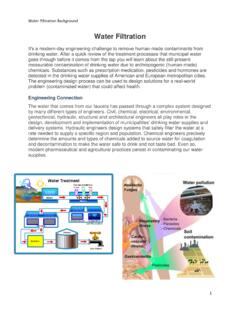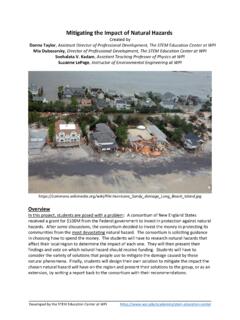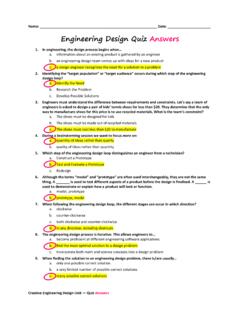Transcription of Passive Home Design - Worcester Polytechnic Institute
1 0 Sawyer Passive home Design A guide to remodeling and building highly energy efficient and eco-friendly homes Passive home Design Report Evan Sawyer Advisor: Robert Krueger 1 Sawyer Table of Contents: Section 1- Insulation and Building walls -vapor barrier and Windows and Section 2- Plumbing Heating and Hot Section 3- Electrical Electrical Lighting, Appliances, & Monitoring Section 4- Weather Exterior Section 5- Interior Section 6- Exterior Green Product and Mfg. 2 Sawyer Introduction- This manual is intended to inform a homebuilder, designer, or owner of many of the important differences between the production and Design of a Passive home and typical house construction.
2 Increasingly, energy conservation and eco-friendly products are becoming more attractive to owners and builders who wish to build sustainably without sacrificing comfort or style. This building technique, when applied properly can develop homes which require no off site energy input annually. In my own life I was confronted with the extremely of nature during a devastating ice storm which destroyed major sections of my home in December, 2008. Rebuilding was a priority for my family but with a new perspective of creating a better living environment which was designed to tolerate possible extremes from the exterior environment.
3 I was ultimately able to rebuild a structure which was completely inadequate with current building codes to impressive new standards of function and efficiency. This experience prompted me to contribute this knowledge to other builders and designers looking to achieve similar efficiency who weren t aware of the impressive traits of the Passive home . It is very important to recognize that every site comes with a completely different set of challenges; homeowners and designers need to be aware of the complexity of designing and engineering a home capable of such high efficiency standards. Failure to understand these challenges and the synergistic nature of the building systems will result in losses in potential efficiency standards.
4 I arranged the information in this 3 Sawyer manual to help to illustrate the connections between these different areas of construction. The six sections that follow show the construction path of a renovation or new construction of a typical residential building, with a focus on the building requirements of the Northeast. The first section of the manual discusses the building envelope and insulation. Also included here is a roadmap of site development and rough construction. Everything from the foundation to the roof is discussed in great detail here; the focus is to explain the critical link between each of the different rough elements of the structure as one complete building envelope.
5 This section doesn t separate these elements because they must be considered together and foremost when designing a Passive home ; the ultimate goal is to achieve a plan that ensures a safer and more rigid structure with incredibly high efficiency standards. The next section provides information about the kinds and types of plumbing systems which should be considered as the next piece of the puzzle. Heating and cooling are the most energy intensive operation of the home . These systems will have to be designed to reflect the mechanical needs of the structure while also minimizing these costs. A Passive home would rely on the coordination of envelope Design , and natural energy production to ensure that heating, cooling, and domestic water production can be accomplished inexpensively and eco-consciously.
6 The third section extensively covers the electrical systems within the home ; also includes in this section is the telecommunications infrastructure used to link the audio, 4 Sawyer visual, security, and smart elements of the home together. The electrical system is also essential in delivering and maintaining power inside the home . These systems should also be designed to maximize the potential of existing natural energy production. Coordinating the Design of electrical systems with the other elements described above can create an automated, efficient , smart home . The fourth section explains the important elements of weatherization and weather protection.
7 This is included because protecting the investment of any home is just as important as location. Utilizing these techniques will ensure that the home can continue to perform at high standards for longer periods of time. Water, snow, and air break down the envelope of the home but advanced weatherization options work to combat harmful natural forces. Failing to recognize weatherization as a main component of this process will result in premature exposure and break down of critical building components. The final two section feature in interior and exterior environment of the home . These two sections describe various ways in which the builder or designer can achieve higher efficiency standards while making these areas comfortable and modern.
8 These spaces often express personal tastes and styles and can be coordinated to accomplish this while still utilizing all the natural abundances of the particular site. Despite these two sections being the final parts of this manual they contain information that will resonate throughout the Design and build process. Functionality and efficiency are mainstays of these designs and are only enhanced by choices made in the interior and exterior environments. 5 Sawyer 1. - Insulation & Building Envelope One critical building element which distinguishes a Passive house from a traditional home is the building envelope and insulation structure.
9 The building envelope is the contiguous structure which separates the interior environment from the exterior environment (ACEEE). New building techniques enable builders to achieve a much higher R-value, the measure of thermal resistance of the home against natural climate, which can have a tremendous impact on energy consumption over the life of the home . The higher an R-value a home can achieve, the more energy efficient and comfortable it will be. Also import in understanding the efficiency of a modern home is the HERs rating system or home energy rating system. This is an index, based 150 to 0, which describes the overall energy efficiency of the building according to the amount of energy input it requires or is projected to require.
10 The average home scores roughly 100 on this index while a properly built Passive home can easily score 0, or not need any outside energy input annually (ResNet). The building envelope consists of several elements which must be coordinated and designed to minimize heating and cooling losses. In a typical stick built home , or a home with a wooden skeleton, these elements would include: Foundation walls Vapor barrier Insulation Windows and doors Roof 6 Sawyer Utilizing the right materials and technologies in designing these systems enables a designer or homebuilder to better control the environment within the home while ensuring it is extremely energy efficient (Oberlender, 258).



















